Abstract
Aromatic amines are well known as occupational carcinogens and are found in cooked foods, tobacco smoke, synthetic fuels, and agricultural chemicals. For the primary arylamines, metabolic N-oxidation by hepatic cytochromes P-450 is generally regarded as an initial activation step leading to carcinogenesis. The metabolic activation of 4-aminobiphenyl, 2-naphthylamine, and several heterocyclic amines has been shown recently to be catalyzed by rat cytochrome P-450ISF-G and by its human ortholog, cytochrome P-450PA. We now report that human hepatic microsomal caffeine 3-demethylation, the initial major step in caffeine biotransformation in humans, is selectively catalyzed by cytochrome P-450PA. Caffeine 3-demethylation was highly correlated with 4-aminobiphenyl N-oxidation (r = 0.99; P less than 0.0005) in hepatic microsomal preparations obtained from 22 human organ donors, and both activities were similarly decreased by the selective inhibitor, 7,8-benzoflavone. The rates of microsomal caffeine 3-demethylation, 4-aminobiphenyl N-oxidation, and phenacetin O-deethylation were also significantly correlated with each other and with the levels of immunoreactive human cytochrome P-450PA. Moreover, a rabbit polyclonal antibody raised to human cytochrome P-450PA was shown to inhibit strongly all three of these activities and to inhibit the N-oxidation of the carcinogen 2-naphthylamine and the heterocyclic amines, 2-amino-6-methyldipyrido-[1,2-a:3',2'-d]imidazole and 2-amino-3-methylimidazo[4,5-f]-quinoline. Human liver cytochrome P-450PA was also shown to catalyze caffeine 3-demethylation, 4-aminobiphenyl N-oxidation, and phenacetin O-deethylation. Thus, estimation of caffeine 3-demethylation activity in humans may be useful in the characterization of arylamine N-oxidation phenotypes and in the assessment of whether or not the hepatic levels of cytochrome P-450PA, as affected by environmental or genetic factors, contribute to interindividual differences in susceptibility to arylamine-induced cancers.
Full text
PDF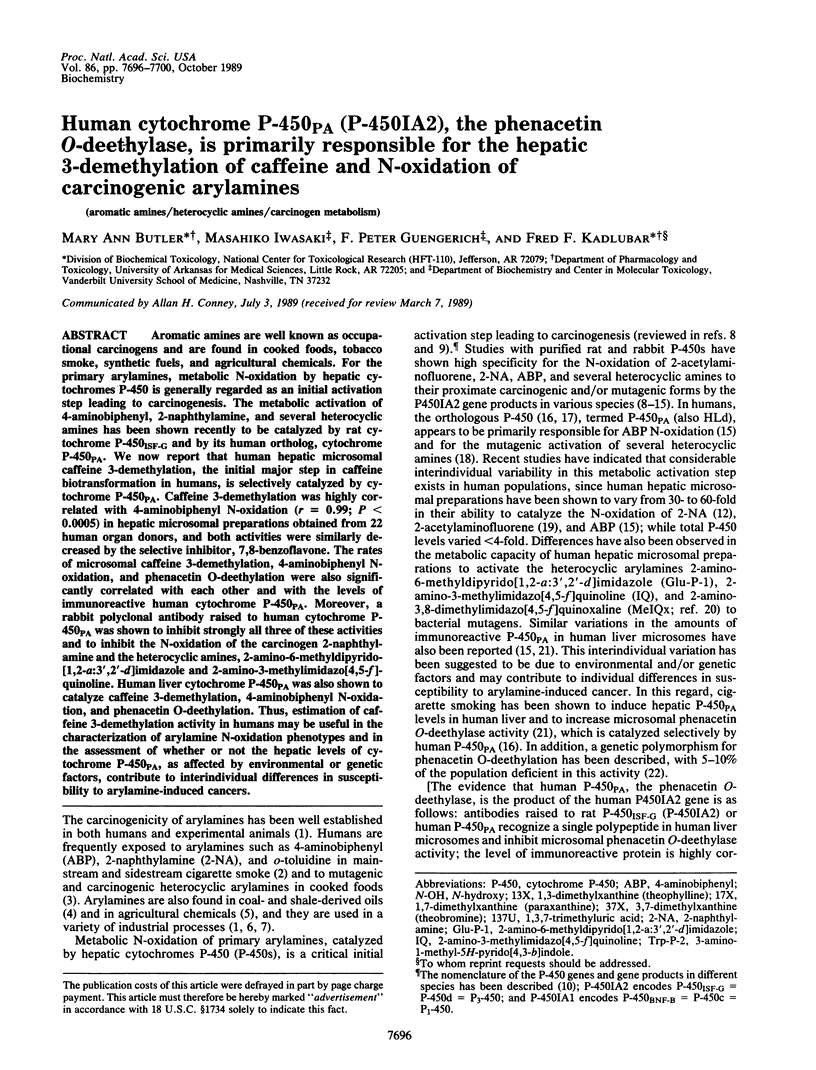
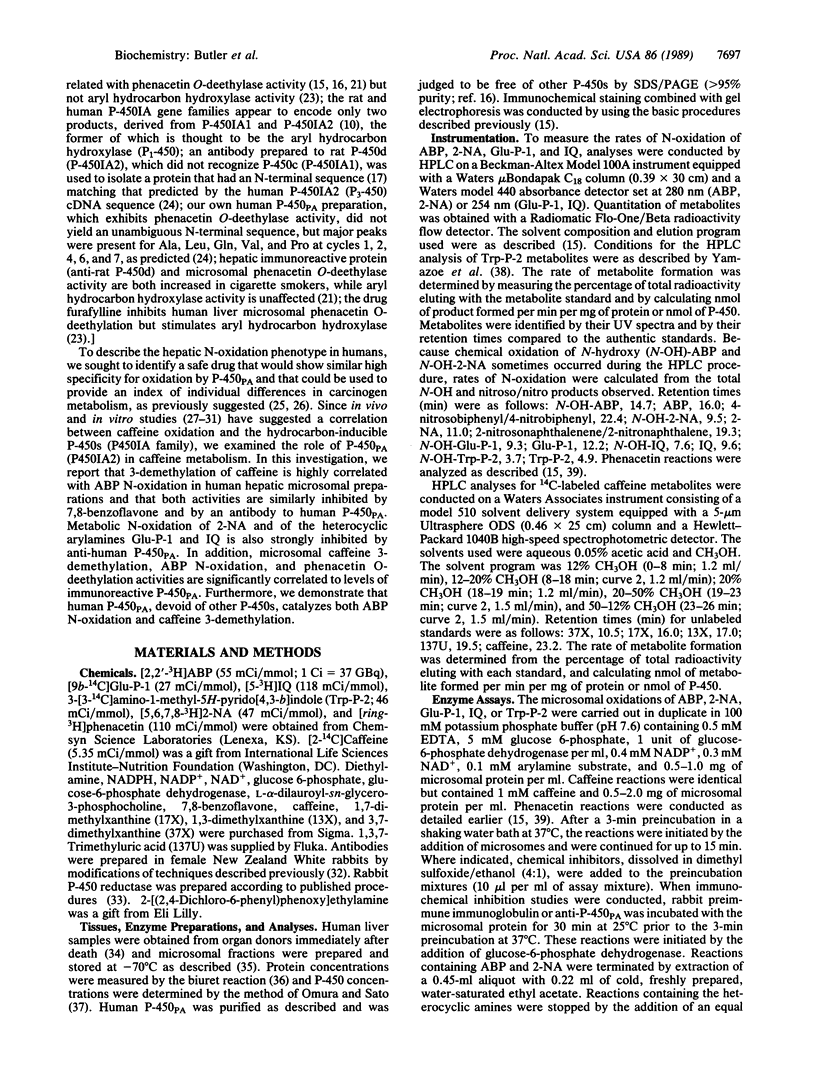
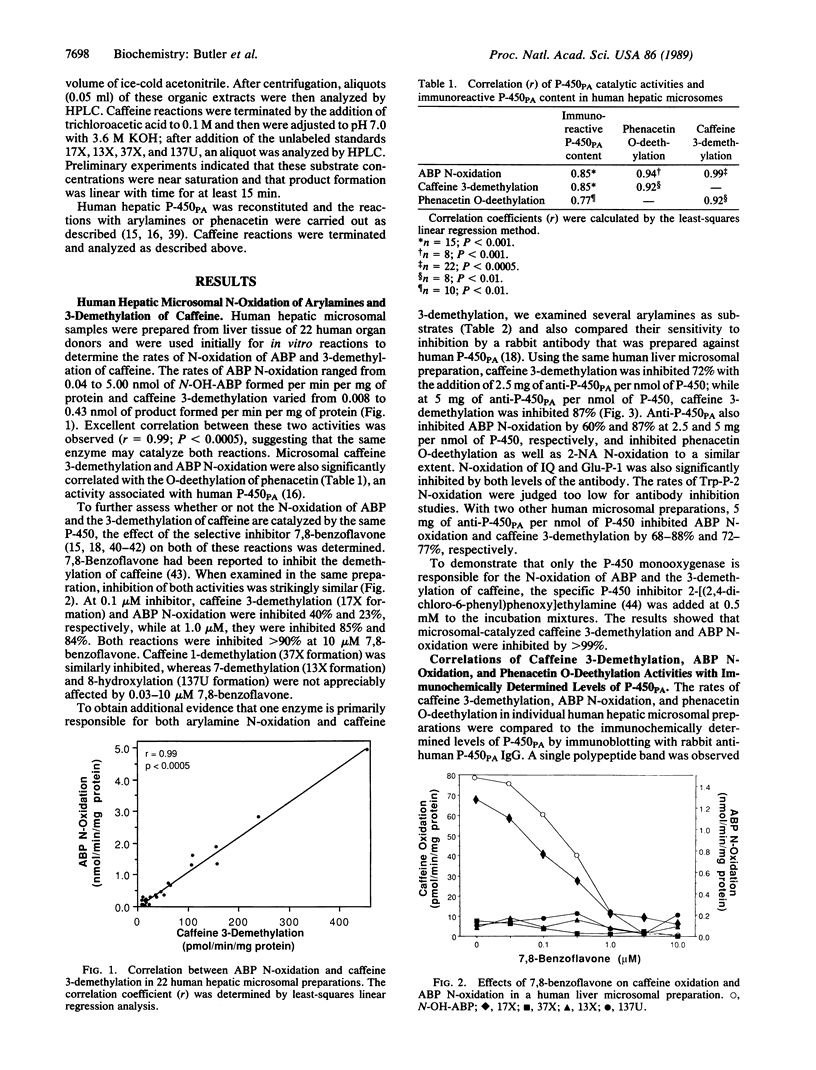
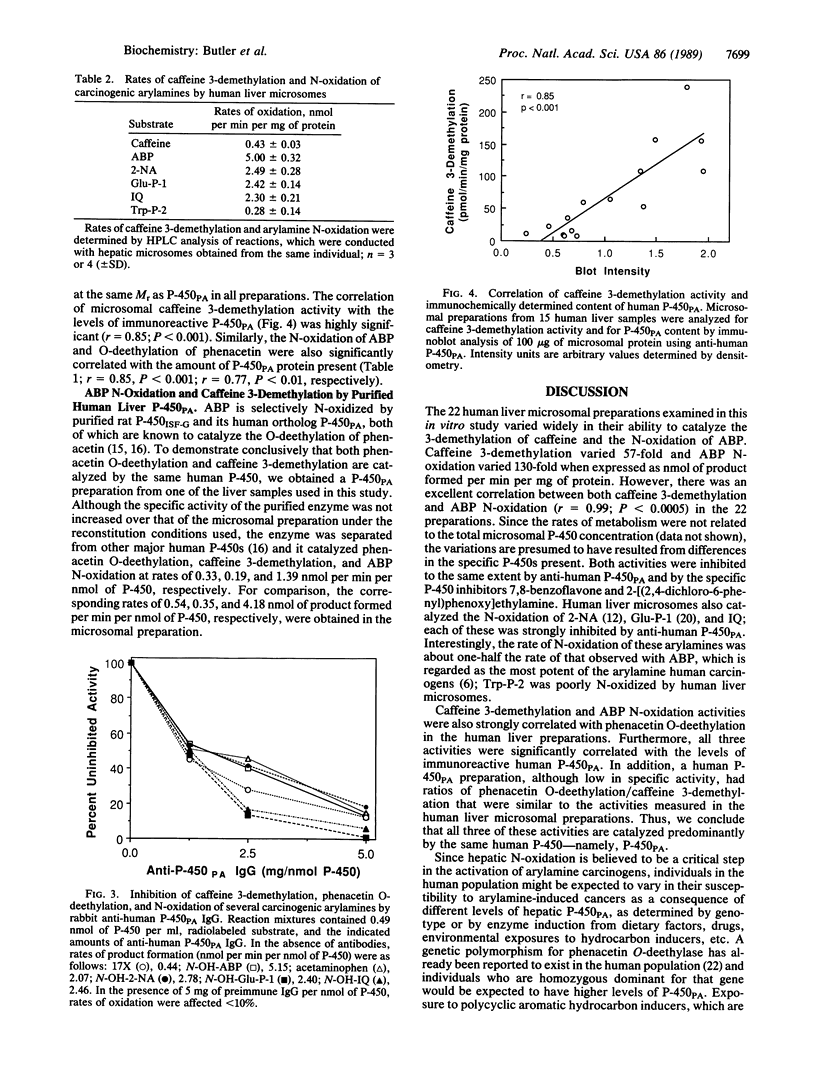
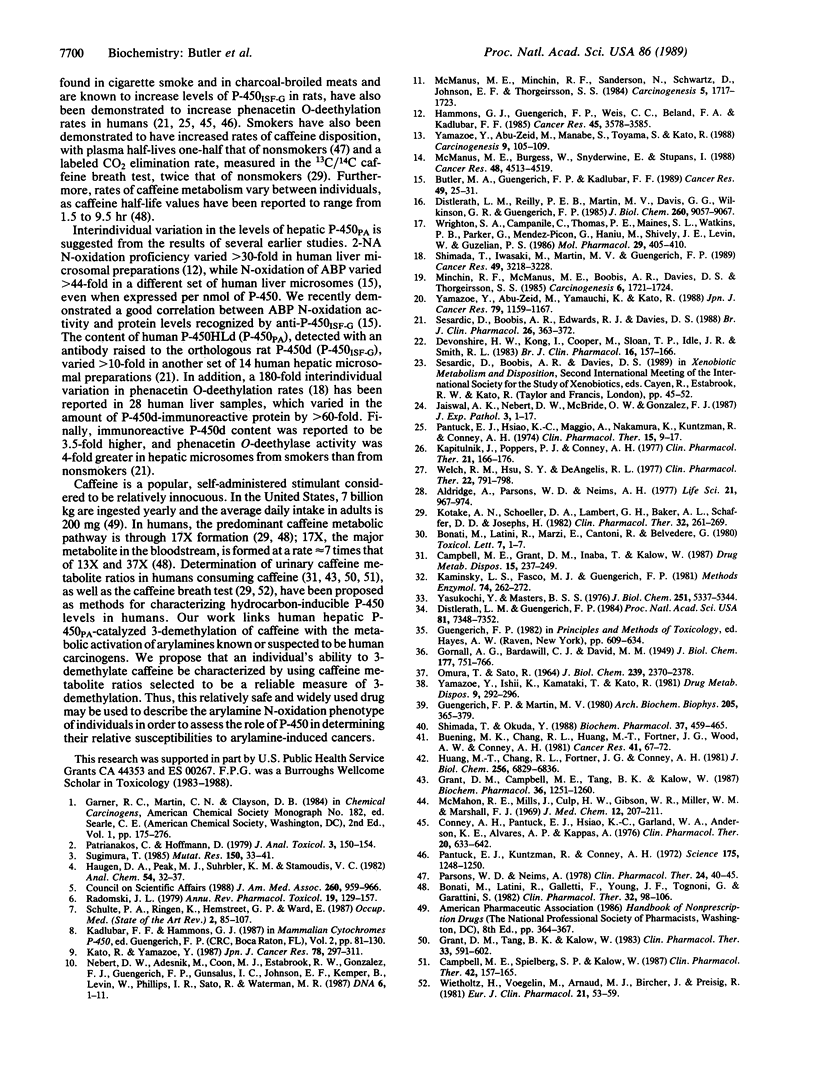
Selected References
These references are in PubMed. This may not be the complete list of references from this article.
- Aldridge A., Parsons W. D., Neims A. H. Stimulation of caffeine metabolism in the rat by 3-methylcholanthrene. Life Sci. 1977 Oct 1;21(7):967–974. doi: 10.1016/0024-3205(77)90263-6. [DOI] [PubMed] [Google Scholar]
- Bonati M., Latini R., Galletti F., Young J. F., Tognoni G., Garattini S. Caffeine disposition after oral doses. Clin Pharmacol Ther. 1982 Jul;32(1):98–106. doi: 10.1038/clpt.1982.132. [DOI] [PubMed] [Google Scholar]
- Bonati M., Latini R., Marzi E., Cantoni R., Belvedere G. [2-14C]caffeine metabolism in control and 3-methylcholanthrene induced rat liver microsomes by high pressure liquid chromatography. Toxicol Lett. 1980 Nov;7(1):1–7. doi: 10.1016/0378-4274(80)90077-6. [DOI] [PubMed] [Google Scholar]
- Buening M. K., Chang R. L., Huang M. T., Fortner J. G., Wood A. W., Conney A. H. Activation and inhibition of benzo(a)pyrene and aflatoxin B1 metabolism in human liver microsomes by naturally occurring flavonoids. Cancer Res. 1981 Jan;41(1):67–72. [PubMed] [Google Scholar]
- Butler M. A., Guengerich F. P., Kadlubar F. F. Metabolic oxidation of the carcinogens 4-aminobiphenyl and 4,4'-methylene-bis(2-chloroaniline) by human hepatic microsomes and by purified rat hepatic cytochrome P-450 monooxygenases. Cancer Res. 1989 Jan 1;49(1):25–31. [PubMed] [Google Scholar]
- Campbell M. E., Grant D. M., Inaba T., Kalow W. Biotransformation of caffeine, paraxanthine, theophylline, and theobromine by polycyclic aromatic hydrocarbon-inducible cytochrome(s) P-450 in human liver microsomes. Drug Metab Dispos. 1987 Mar-Apr;15(2):237–249. [PubMed] [Google Scholar]
- Campbell M. E., Spielberg S. P., Kalow W. A urinary metabolite ratio that reflects systemic caffeine clearance. Clin Pharmacol Ther. 1987 Aug;42(2):157–165. doi: 10.1038/clpt.1987.126. [DOI] [PubMed] [Google Scholar]
- Conney A. H., Pantuck E. J., Hsiao K. C., Garland W. A., Anderson K. E., Alvares A. P., Kappas A. Enhanced phenacetin metabolism in human subjects fed charcoal-broiled beef. Clin Pharmacol Ther. 1976 Dec;20(6):633–642. doi: 10.1002/cpt1976206633. [DOI] [PubMed] [Google Scholar]
- Devonshire H. W., Kong I., Cooper M., Sloan T. P., Idle J. R., Smith R. L. The contribution of genetically determined oxidation status to inter-individual variation in phenacetin disposition. Br J Clin Pharmacol. 1983 Aug;16(2):157–166. doi: 10.1111/j.1365-2125.1983.tb04980.x. [DOI] [PMC free article] [PubMed] [Google Scholar]
- Distlerath L. M., Guengerich F. P. Characterization of a human liver cytochrome P-450 involved in the oxidation of debrisoquine and other drugs by using antibodies raised to the analogous rat enzyme. Proc Natl Acad Sci U S A. 1984 Dec;81(23):7348–7352. doi: 10.1073/pnas.81.23.7348. [DOI] [PMC free article] [PubMed] [Google Scholar]
- Distlerath L. M., Reilly P. E., Martin M. V., Davis G. G., Wilkinson G. R., Guengerich F. P. Purification and characterization of the human liver cytochromes P-450 involved in debrisoquine 4-hydroxylation and phenacetin O-deethylation, two prototypes for genetic polymorphism in oxidative drug metabolism. J Biol Chem. 1985 Jul 25;260(15):9057–9067. [PubMed] [Google Scholar]
- Grant D. M., Campbell M. E., Tang B. K., Kalow W. Biotransformation of caffeine by microsomes from human liver. Kinetics and inhibition studies. Biochem Pharmacol. 1987 Apr 15;36(8):1251–1260. doi: 10.1016/0006-2952(87)90078-5. [DOI] [PubMed] [Google Scholar]
- Grant D. M., Tang B. K., Kalow W. Variability in caffeine metabolism. Clin Pharmacol Ther. 1983 May;33(5):591–602. doi: 10.1038/clpt.1983.80. [DOI] [PubMed] [Google Scholar]
- Guengerich F. P., Martin M. V. Purification of cytochrome P-450, NADPH-cytochrome P-450 reductase, and epoxide hydratase from a single preparation of rat liver microsomes. Arch Biochem Biophys. 1980 Dec;205(2):365–379. doi: 10.1016/0003-9861(80)90119-8. [DOI] [PubMed] [Google Scholar]
- Hammons G. J., Guengerich F. P., Weis C. C., Beland F. A., Kadlubar F. F. Metabolic oxidation of carcinogenic arylamines by rat, dog, and human hepatic microsomes and by purified flavin-containing and cytochrome P-450 monooxygenases. Cancer Res. 1985 Aug;45(8):3578–3585. [PubMed] [Google Scholar]
- Huang M. T., Chang R. L., Fortner J. G., Conney A. H. Studies on the mechanism of activation of microsomal benzo[a]pyrene hydroxylation by flavonoids. J Biol Chem. 1981 Jul 10;256(13):6829–6836. [PubMed] [Google Scholar]
- Jaiswal A. K., Nebert D. W., McBride O. W., Gonzalez F. J. Human P(3)450: cDNA and complete protein sequence, repetitive Alu sequences in the 3' nontranslated region, and localization of gene to chromosome 15. J Exp Pathol. 1987 Winter;3(1):1–17. [PubMed] [Google Scholar]
- Kaminsky L. S., Fasco M. J., Guengerich F. P. Production and application of antibodies to rat liver cytochrome P-450. Methods Enzymol. 1981;74(Pt 100):262–272. doi: 10.1016/0076-6879(81)74018-7. [DOI] [PubMed] [Google Scholar]
- Kapitulnik J., Popper P. J., Conney A. H. Comparative metabolism of benzo[a]pyrene and drugs in human liver. Clin Pharmacol Ther. 1977 Feb;21(2):166–176. doi: 10.1002/cpt1977212166. [DOI] [PubMed] [Google Scholar]
- Kato R., Yamazoe Y. Metabolic activation and covalent binding to nucleic acids of carcinogenic heterocyclic amines from cooked foods and amino acid pyrolysates. Jpn J Cancer Res. 1987 Apr;78(4):297–311. [PubMed] [Google Scholar]
- Kotake A. N., Schoeller D. A., Lambert G. H., Baker A. L., Schaffer D. D., Josephs H. The caffeine CO2 breath test: dose response and route of N-demethylation in smokers and nonsmokers. Clin Pharmacol Ther. 1982 Aug;32(2):261–269. doi: 10.1038/clpt.1982.157. [DOI] [PubMed] [Google Scholar]
- McMahon R. E., Mills J., Culp H. W., Gibson W. R., Miller W. M., Marshall F. J. Demethylation studies. VI. The inhibition of hepatic microsomal oxygenation by 2,4-dichloro(6-phenylphenoxy)ethylamine and related compounds. J Med Chem. 1969 Mar;12(2):207–211. doi: 10.1021/jm00302a002. [DOI] [PubMed] [Google Scholar]
- McManus M. E., Burgess W., Snyderwine E., Stupans I. Specificity of rabbit cytochrome P-450 isozymes involved in the metabolic activation of the food derived mutagen 2-amino-3-methylimidazo[4,5-f] quinoline. Cancer Res. 1988 Aug 15;48(16):4513–4519. [PubMed] [Google Scholar]
- McManus M. E., Minchin R. F., Sanderson N., Schwartz D., Johnson E. F., Thorgeirsson S. S. Metabolic processing of 2-acetylaminofluorene by microsomes and six highly purified cytochrome P-450 forms from rabbit liver. Carcinogenesis. 1984 Dec;5(12):1717–1723. doi: 10.1093/carcin/5.12.1717. [DOI] [PubMed] [Google Scholar]
- Minchin R. F., McManus M. E., Boobis A. R., Davies D. S., Thorgeirsson S. S. Polymorphic metabolism of the carcinogen 2-acetylaminofluorene in human liver microsomes. Carcinogenesis. 1985 Dec;6(12):1721–1724. doi: 10.1093/carcin/6.12.1721. [DOI] [PubMed] [Google Scholar]
- Nebert D. W., Adesnik M., Coon M. J., Estabrook R. W., Gonzalez F. J., Guengerich F. P., Gunsalus I. C., Johnson E. F., Kemper B., Levin W. The P450 gene superfamily: recommended nomenclature. DNA. 1987 Feb;6(1):1–11. doi: 10.1089/dna.1987.6.1. [DOI] [PubMed] [Google Scholar]
- OMURA T., SATO R. THE CARBON MONOXIDE-BINDING PIGMENT OF LIVER MICROSOMES. I. EVIDENCE FOR ITS HEMOPROTEIN NATURE. J Biol Chem. 1964 Jul;239:2370–2378. [PubMed] [Google Scholar]
- Pantuck E. J., Hsiao K. C., Maggio A., Nakamura K., Kuntzman R., Conney A. H. Effect of cigarette smoking on phenacetin metabolism. Clin Pharmacol Ther. 1974 Jan;15(1):9–17. doi: 10.1002/cpt19741519. [DOI] [PubMed] [Google Scholar]
- Pantuck E. J., Kuntzman R., Conney A. H. Decreased concentration of phenacetin in plasma of cigarette smokers. Science. 1972 Mar 17;175(4027):1248–1250. doi: 10.1126/science.175.4027.1248. [DOI] [PubMed] [Google Scholar]
- Parsons W. D., Neims A. H. Effect of smoking on caffeine clearance. Clin Pharmacol Ther. 1978 Jul;24(1):40–45. doi: 10.1002/cpt197824140. [DOI] [PubMed] [Google Scholar]
- Radomski J. L. The primary aromatic amines: their biological properties and structure-activity relationships. Annu Rev Pharmacol Toxicol. 1979;19:129–157. doi: 10.1146/annurev.pa.19.040179.001021. [DOI] [PubMed] [Google Scholar]
- Schulte P. A., Ringen K., Hemstreet G. P., Ward E. Occupational cancer of the urinary tract. Occup Med. 1987 Jan-Mar;2(1):85–107. [PubMed] [Google Scholar]
- Sesardic D., Boobis A. R., Edwards R. J., Davies D. S. A form of cytochrome P450 in man, orthologous to form d in the rat, catalyses the O-deethylation of phenacetin and is inducible by cigarette smoking. Br J Clin Pharmacol. 1988 Oct;26(4):363–372. doi: 10.1111/j.1365-2125.1988.tb03393.x. [DOI] [PMC free article] [PubMed] [Google Scholar]
- Shimada T., Iwasaki M., Martin M. V., Guengerich F. P. Human liver microsomal cytochrome P-450 enzymes involved in the bioactivation of procarcinogens detected by umu gene response in Salmonella typhimurium TA 1535/pSK1002. Cancer Res. 1989 Jun 15;49(12):3218–3228. [PubMed] [Google Scholar]
- Shimada T., Okuda Y. Metabolic activation of environmental carcinogens and mutagens by human liver microsomes. Role of cytochrome P-450 homologous to a 3-methylcholanthrene-inducible isozyme in rat liver. Biochem Pharmacol. 1988 Feb 1;37(3):459–465. doi: 10.1016/0006-2952(88)90215-8. [DOI] [PubMed] [Google Scholar]
- Sugimura T. Carcinogenicity of mutagenic heterocyclic amines formed during the cooking process. Mutat Res. 1985 Jun-Jul;150(1-2):33–41. doi: 10.1016/0027-5107(85)90098-3. [DOI] [PubMed] [Google Scholar]
- Welch R. M., Hsu S. Y., DeAngelis R. L. Effect of Aroclor 1254, phenobarbital, and polycyclic aromatic hydrocarbons on the plasma clearance of caffeine in the rat. Clin Pharmacol Ther. 1977 Nov;22(5 Pt 2):791–798. doi: 10.1002/cpt1977225part2791. [DOI] [PubMed] [Google Scholar]
- Wietholtz H., Voegelin M., Arnaud M. J., Bircher J., Preisig R. Assessment of the cytochrome P-448 dependent liver enzyme system by a caffeine breath test. Eur J Clin Pharmacol. 1981;21(1):53–59. doi: 10.1007/BF00609588. [DOI] [PubMed] [Google Scholar]
- Wrighton S. A., Campanile C., Thomas P. E., Maines S. L., Watkins P. B., Parker G., Mendez-Picon G., Haniu M., Shively J. E., Levin W. Identification of a human liver cytochrome P-450 homologous to the major isosafrole-inducible cytochrome P-450 in the rat. Mol Pharmacol. 1986 Apr;29(4):405–410. [PubMed] [Google Scholar]
- Yamazoe Y., Abu-Zeid M., Manabe S., Toyama S., Kato R. Metabolic activation of a protein pyrolysate promutagen 2-amino-3,8-dimethylimidazo[4,5-f]quinoxaline by rat liver microsomes and purified cytochrome P-450. Carcinogenesis. 1988 Jan;9(1):105–109. doi: 10.1093/carcin/9.1.105. [DOI] [PubMed] [Google Scholar]
- Yamazoe Y., Abu-Zeid M., Yamauchi K., Kato R. Metabolic activation of pyrolysate arylamines by human liver microsomes; possible involvement of a P-488-H type cytochrome P-450. Jpn J Cancer Res. 1988 Nov;79(11):1159–1167. doi: 10.1111/j.1349-7006.1988.tb01540.x. [DOI] [PMC free article] [PubMed] [Google Scholar]
- Yamazoe Y., Ishii K., Kamataki T., Kato R. Structural elucidation of a mutagenic metabolite of 3-amino-1-methyl-5H-pyrido[4,3-b]indole. Drug Metab Dispos. 1981 May-Jun;9(3):292–296. [PubMed] [Google Scholar]
- Yasukochi Y., Masters B. S. Some properties of a detergent-solubilized NADPH-cytochrome c(cytochrome P-450) reductase purified by biospecific affinity chromatography. J Biol Chem. 1976 Sep 10;251(17):5337–5344. [PubMed] [Google Scholar]


